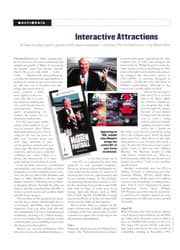
Rx for Dog Jocks
By the time Welz, a red-and-black German shepherd, came to Dr. John Anderson's attention, he was one sick animal. In six years of work with John Bell, now a sergeant with the Inglewood Police Department in California, Welz had helped apprehend 1,500 suspects, find several lost children and save seven people—including Bell. Welz and Bell had won awards in police-dog trials all over the state. California criminals knew of Welz's smarts and tenacity, yet children could poke him in the eye and grab his ears. But now something was clearly wrong.
"Welz was normally feisty, independent and strong-willed," Bell recalls. "Then he began losing weight. He wanted to be by my side more, while before he had liked his own space, liked to find a corner by himself. He wouldn't eat, and when he woke up in the morning he was shaking like a leaf."
Bell took Welz to Dr. Anderson, a veterinarian who practices in Simi Valley and specializes in treating police dogs. Anderson was concerned by the dog's condition. "Welz was underweight," he says. "His coat was rough. He had diarrhea. He was lethargic. He couldn't make it through a night's work without lying down."
Police dogs are used to on-the-job injuries. They get kicked, shot, burned and stabbed; they break their jaws and fall off buildings. Welz had already been through much of that; he had been shot at six times, hit over the head with a tire iron and thrown from a patrol car. ("I forgot to roll up the window before we started a chase," Bell admits.) This time, though, it turned out that Welz had a different kind of work-related ailment. "These dogs are sensitive, alert and ready for action at all times," says Anderson. "They have to react with split-second timing, yet they have to remain obedient. That's extremely stressful."
After undergoing a long series of tests, Welz was found to be suffering from colitis. To control the physiological symptoms, Anderson prescribed more easily digestible food, a new feeding schedule and medication. Equally important, Anderson helped Bell realize that he had been pushing the dog too hard. "We were in the midst of a lot of competitions," Bell says. "Plus, we were working every day. I constantly demanded perfection, because I wanted to be the perfect cop. Welz just wanted to be my buddy."
To ease the pressure on his companion, Bell started spending more time playing with the dog. "That was a hell of a lot more fun," he says now. "And Welzie came back. He really responded."
Dogs have been involved in strenuous activity, often of a sporting nature, for thousands of years. Only recently, however, have veterinarians and handlers begun supplementing conventional dog care with procedures and therapies borrowed from sports medicine. A number of veterinary schools now have sports-medicine departments. And three years ago a group of veterinarians established the American Canine Sports Medicine Association, the field's first national group. The 300-member ACSMA promotes research into the care and treatment of canine athletes, not only familiar jocks such as sled dogs and racing greyhounds but also true working stiffs such as police and herding dogs. And while the specialties of member vets include those found in human sports medicine—conditioning, nutrition, diagnostics, orthopedics and the like—they also take in some uniquely doggy matters: sniffing styles, droopy tails and paw dynamics.
Much of the thrust behind this new field comes from the popularity of dog sports. Since the expansion of greyhound racing in the U.S. in the late 1980s the sport has taken off. Sled-dog races are held around the world, and across the U.S. thousands of field trials take place every year.
"As more and more veterinarians administer to sports dogs, we've realized we need to know as much as human and equine specialists do," says Dr. Mark Bloomberg, chairman of the Small Animal Clinical Sciences department at the University of Florida. "For years we have been able to make an injured dog walk. Now we want the dog to regain its full athletic potential."
For a greyhound that means being able to run 40 miles per hour, as fast as a thoroughbred. And while leg injuries for a 70-pound dog aren't as severe as they are for a 1,200-pound horse, the dog's speed puts enough pressure on his shoulders, legs and feet to cause sprains, fractures and muscle tears—almost always on turns.
Dr. Robert Taylor, an orthopedic veterinary surgeon in Denver, has designed postoperative therapies that have been remarkably successful in getting injured racing dogs back on the track. HM'S Mystique, a 4-year-old red-and-white greyhound whose great-grandfather Downing was featured in SI in 1977, bears witness to Dr. Taylor's work. Mystique, called Puzzle by his owners, Gail Hesse and Dr. Lester McLachlan of St. Petersburg, Fla., had been a top-level racer with Mountain Valley Kennels in Denver when he suffered a subluxation, or separation, of the intertarsal joint in his left hock in June 1992.
Such an injury could easily turn a champion sprinter into a lap dog. Puzzle was lucky. Dr. Taylor put the joint back together with screws and then put Puzzle through six weeks of physical therapy, including warm baths, slow walks, stair climbing, running, resistive swimming, weight bearing and neuromuscular stimulation. The dog returned to the track nine months after hurting himself.
"No one really thought he'd come back after such a bad injury," Hesse says. "But he was a grade-A racer again. Before his accident he was in the money 65% of the time. Afterward he was in the money 50% of the time."
Injuries suffered by field-trial dogs—pointers, setters and retrievers who prove their mettle by flushing or finding game—are more like those sustained by marathon runners. In some trials dogs may run for three hours. "A bad step in a plowed field or an awkward jump can really do damage," says ACSMA president Dr. Terrance Terlep. Hogan, a yellow Labrador, showed great promise as a competitive retriever until the spring of 1991. "He had always been a good worker," says his owner, Jan Martin of Victoria, B.C. "He was stylish, excitable and always showed enthusiasm. Then he stopped working well. It wasn't a specific accident. He just started doing stupid things."
Martin took Hogan to Dr. Barclay Slocum, a veterinary orthopedist in Eugene, Ore., who found that the 3-year-old had ruptured a cruciate ligament. Slocum had devised successful cruciate surgery, which he used to help Hogan, and the following spring the Lab won a major competition in Canada. Four months later, though, he ruptured another cruciate ligament and simultaneously tore an Achilles tendon. This called for a second cruciate operation as well as a pin job on the torn Achilles. Three months later Hogan broke the pin; it had to be taken out. The injury-prone dog is back in training, and Martin has her fingers crossed. "Who knows what will happen next?" she says. "But I have high hopes for this dog."
Sled dogs that race in Alaska's 1,157-mile Iditarod or the 1,000-mile Yukon Quest face still other problems, including accidents that are unique to life in the bush. Bugs, a 2-year-old husky, fell into a hole made by a moose's hoof and broke his hind leg. Josie, a lead sled dog, was run over by a snowmobile. Luckily the dogs' owner, Dr. Karin Schmidt of Anchorage, is a veterinarian. She put both of them back together again.
When temperatures dip as low as-60°F, even cold-weather natives such as the Alaskan husky get frostbite and sore paws. Mushers wrap their dogs' genitalia in fleece and put protective booties on the dogs' feet. Meanwhile, research veterinarians at Auburn University have been looking into "paw dynamics" to see which kinds of snow cause the most damage and whether team position plays a role in the types of injuries that dogs incur. The findings of such studies may affect racing strategies. Researchers at Auburn's Sports Medicine Program are also developing treatment and reconstructive-surgery techniques for damaged paws and pads.
Canine sports specialists are interested in other issues, too, including the diverse nutritional needs of sporting dogs (sled dogs typically consume 12,000 calories daily, 60% of which should be fat, while greyhounds need about 60% protein) and surgeries for hip dysplasia, a problem common among the sporting and working breeds. And researchers at Auburn are investigating "limber tail" (in which the tail doesn't point properly), olfactory functions and conditioning techniques for field dogs.
Despite recognizing the wear and tear sustained by canine athletes, ACSMA members are careful to distance themselves from any animal-rights debate. "We're equally friendly with sports groups and animal-rights activists," says Dr. Ronald Stone, the ACSMA's secretary. "As long as the sport exists, we want the dog to be healthy."
Says Terlep, "Most dogs love their work. Most handlers love their dogs. They can't win at the dog's expense."
PHOTO
SUSAN DAVIS
Above: Injuries need not end a greyhound's career; Puzzle (far right) made a full recovery.
TWO PHOTOS
ALAMEDA EAST VETERINARY HOSPITAL
[See caption above.]
PHOTO
PHILO GROMMON IV
[See caption above.]
PHOTO
JEFF SCHULTZ/ALASKA STOCK
Schmidt, both a musher and a vet, treats her athletes herself.
Susan Davis is a freelance journalist who lives in San Francisco.

